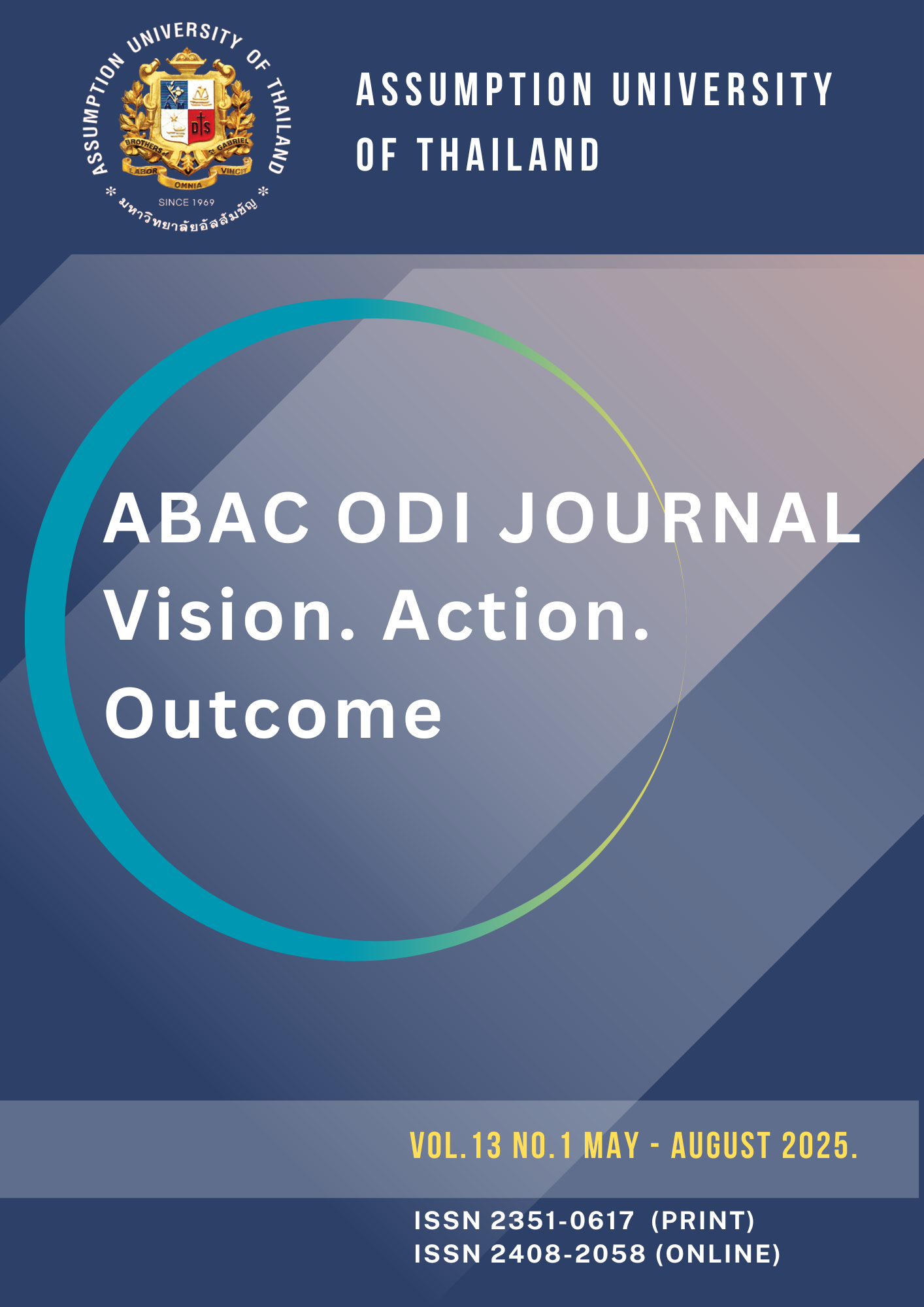Key Strategies to Enhance Team Resilience for NGO Sustainability: A Case of Charity Corps Myanmar
DOI:
https://doi.org/10.14456/abacodijournal.2025.25Keywords:
Team Resilience, Transformational Leadership, Collective Efficacy, Team Familiarity, Organizational PracticeAbstract
This study discusses ways to improve team resilience in a non-governmental organization operating in a challenging socio-political context: Charity Corps Myanmar. The study employs qualitative techniques to understand the role of transformational leadership, collective efficacy, team familiarity, and organizational practices in ensuring team resilience and organizational sustainability. Using data from interviews and applying thematic analysis shows important gaps in team dynamics and operation practices that reduce resilience. Using Appreciative Inquiry (AI) and SOAR analysis, this work represents a unique synthesis of frameworks in the context of an NGO and new perspectives on resilience building. They will consider your key takeaways on the importance of adaptability, collaboration and structured organizational practice. To foster transformational leaders and enhance team cohesion and operational efficiency, the study recommends implementing structured leadership training programs and improving communication channels. Our findings offer a useful perspective to NGOs working in high-risk contexts and practical strategies to better resist the challenges they face while serving their mission and accomplishing their objectives.
References
Alliger, G. M., Cerasoli, C. P., Tannenbaum, S. I., & Vessey, W. B. (2015). Team resilience. Organizational Dynamics, 44(3), 176-184.
Https://doi.org/10.1016/j.orgdyn.2015.05.003
Aung, O. M., & Fernando, M. S. C. L. (2022). Resilient organization roadmap for sustained organization using a generative approach: a case of Landesa Myanmar. ABAC ODI Journal Vision. Action. Outcome, 10(1), 42-65.
Https://doi.org/10.14456/abacodijournal.2022.17
Bandura, A. (2012). On the functional properties of perceived self-efficacy revisited. Journal of Management, 38(1), 9-44. Https://doi.org/10.1177/0149206311410606
Bass, B. M., & Riggio, R. E. (2006). Transformational leadership. Psychology Press e-books. Https://doi.org/10.4324/9781410617095
Bonanno, G. A. (2004). Loss, trauma, and human resilience: have we underestimated the human capacity to thrive after extremely aversive events. American Psychologist, 59(1), 20-28. https://doi.org/10.1037/0003-066x.59.1.20
Carmeli, A., Friedman, Y., & Tishler, A. (2012). Cultivating a resilient top management team: The importance of relational connections and strategic decision comprehensiveness. Safety Science, 51(1), 148-159.
https://doi.org/10.1016/j.ssci.2012.06.002
Garrett, M. D. (2023). Creating visionaries through positive leadership: shifting educational paradigms towards strengths. Canadian Journal of Educational Administration and Policy, 203, 91-101. https://doi.org/10.7202/1108434ar
Duchek, S. (2020). Organizational resilience: a capability-based conceptualization. Business research, 13(1), 215-246. https://doi.org/10.1007/s40685-019-0085-7
Espinosa, J. A., Slaughter, S. A., Kraut, R. E., & Herbsleb, J. D. (2007). Team knowledge and coordination in geographically distributed software development. Journal of Management Information Systems, 24(1), 135-169.
Https://doi.org/10.2753/mis0742-1222240104
Gully, S. M., Incalcaterra, K. A., Joshi, A., & Beaubien, J. M. (2002). A meta-analysis of team-efficacy, potency, and performance: interdependence and level of analysis as moderators of observed relationships. Journal of Applied Psychology, 87(5), 819-832. Https://doi.org/10.1037/0021-9010.87.5.819
Huckman, R. S., Staats, B. R., & Upton, D. M. (2009). Team familiarity, role experience, and performance: evidence from Indian software services. Management Science, 55(1), 85-100. https://doi.org/10.1287/mnsc.1080.0923
Lengnick-Hall, C. A., Beck, T. E., & Lengnick-Hall, M. L. (2011). Developing a capacity for organizational resilience through strategic human resource management. Human Resource Management Review, 21(3), 243-255.
https://doi.org/10.1016/j.hrmr.2010.07.001
Lingard, H., Pink, S., Harley, J., & Edirisinghe, R. (2015). Looking and learning: using participatory video to improve health and safety in the construction industry. Construction Management and Economics, 33(9), 740-751.
https://doi.org/10.1080/01446193.2015.1102301
Luthar, S. S., Cicchetti, D., & Becker, B. (2000). The construct of resilience: a critical evaluation. Child Development, 71(3), 543-562.
https://doi.org/10.1111/1467-8624.00164
Masten, A. S. (2001). Ordinary magic: Resilience processes in development. American Psychologist, 56(3), 227-238. https://doi.org/10.1037/0003-066x.56.3.227
Reed, J. (2006). Appreciative Inquiry: Research For Change. Sage Publications
Reich, J. W., Zautra, A. J., & Hall, J. S. (2010). Handbook of adult resilience. Guilford press.
Stavros, J. M., & Hinrichs, G. (2011). The Thin Book of SOAR: Building Strengths-Based Strategy. Thin Book Publishing.
Stavros, J. M., Godwin, L. N., & Cooperrider, D. L. (2015). Appreciative Inquiry. Wiley.
Stoverink, A. C., Kirkman, B. L., Mistry, S., & Rosen, B. (2020). Bouncing back together: toward a theoretical model of work team resilience. Academy of Management Review, 45(2), 395-422. Https://doi.org/10.5465/amr.2017.0005
Tasa, K., Taggar, S., & Seijts, G. H. (2007). The development of collective efficacy in teams: a multilevel and longitudinal perspective. Journal of Applied Psychology, 92(1), 17-27.
Https://doi.org/10.1037/0021-9010.92.1.17




